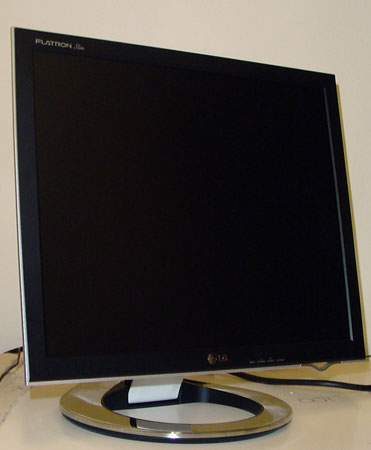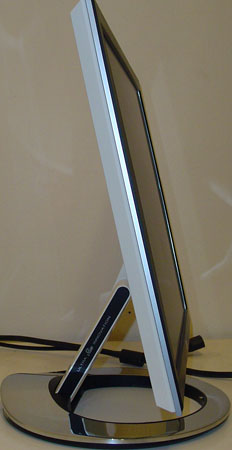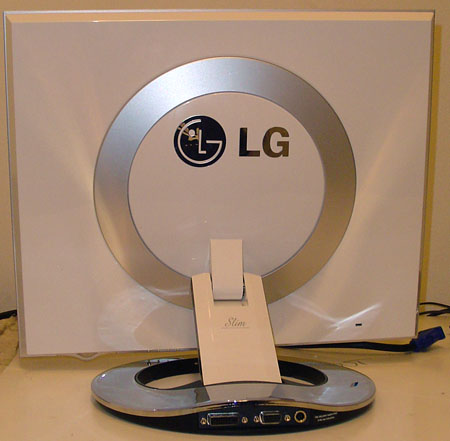LG L1980U LCD: The New 19" Panel on the Block
by Kristopher Kubicki on May 13, 2005 4:00 PM EST- Posted in
- Displays
Construction
Our Flatron L1980U bears a striking resemblance to the Samsung 193P display that we reviewed over a year ago. Both displays use internally housed cable management that run down the rear of the unit, external power supplies and nice, round curving bezels behind the monitor. The LG unit is actually slightly thinner than the SyncMaster 193P, but does not have a universal joint attached to the base. Hence, this display only tilts along the X axis and pivots along the Y axis. The L1980U boasts the specifications listed below:| LG Flatron L1980U | |
| Advertised LCD | 19" SXGA LCD (Active Matrix) pixel pitch: 0.294mm Anti-glare coating TN 6-bit LCD Panel |
| Advertised Scanning Frequency | Horizontal: 30-83kHz Vertical: 56-75Hz |
| Advertised Response Time | 12ms (Typical Gray to Gray) |
| Advertised Viewing Angle | 160 / 160 (Horizontal / Vertical) |
| Advertised Contrast Ratio | 500:1 (Typical) |
| Advertised Compatibility | 1280 x 1024 (Native) |
| Advertised Brightness | 250 cd/m2 |
| Advertised Warranty | 3 years parts and labor |
The first thing that you may notice is the 12ms advertised response time. Unfortunately, there is a growing trend with display manufacturers to not mention whether or not the response time is gray-to-gray (GTG) or average (TrTf) response time. LG.Philips LCD also lists this panel as a 12ms response time unit, but then again, they also list the previous generation panels as 12ms too (the same panel used in our 16ms Sharp LL-191A-B). After much investigation, we determined that the response time was actually 12ms average (TrTf - Time rising, Time falling) response time, but LGE typically advertises the display as an 8ms unit. This is still technically correct, since the display does in fact take 8ms for the Tr (Time rising) – although this does not seem to be explicitly mentioned anywhere convenient. Just keep in mind that this is a low response time LCD, but not lower than other displays that we’ve seen in the past.
Clever marketing aside, there are some other interesting aspects of this display. This is one of the slimmest displays that we have seen to date, and when folded into the monitor, it is only four inches high. The monitor comes with an extra VESA compatible mount plate that can be attached to the base of the unit if you plan on attaching the L1980U to the wall or a VESA arm. Below, you can see another shot of the awesome cable management running down the rear of the display.
Like most LCDs that use intelligent cable management, the LGE L1980U requires an external inverter brick. Using a Kill-A-Watt device to measure power consumption, we found that the display uses 43W when on and just under 2W when on standby (just as the LGE website states). Like the Samsung 193P, there are no exhaust portals on the monitor either. The majority of heat generated in an LCD comes from the AC inverter, so we were not surprised that LG was able to pull this off.













21 Comments
View All Comments
amuster - Monday, June 6, 2005 - link
I have used the LG1980U for the past two months and agree with the AnandTech review. The darks are washed out. I was also surprised by the narrow viewing angle especially from above the screen. However the display is not unpleasant to use and the exterior design is just wonderful. I was very concerned about blurring having previously used a CRT and I wanted an LCD with good response. This screen is fine. If exterior design must be visually appealing to you and accurate colour rendition is not vital then I highly recommend the LG1980U. I was able to purchase the screen for £350 and at this price have no complaints. It is excellent value.Micronaut - Wednesday, May 18, 2005 - link
We just got a 1905FP and it's HORRIBLE for gaming. The blur is very very bad. I cannot recommend it to anyone that has anything moving on the screen (and yes, I've loaded drivers, played with the vscyn, everything). :(Spacecomber - Tuesday, May 17, 2005 - link
The 910N sounds similar to the 910T, though Samsung lists the 910N's specifications as 250cd and 800:1, while the 910T's specifications are listed as 260cd and 1000:1. Both have 170/170 viewing angles. Perhaps these are the same 25ms PVA panel, but tweaked differently by the monitor's circuitry and backlighting. The main difference is that the 910N looks to be a budget version, in that it is analog only, while the 910T has a DVI connection. Perhaps the lack of the DVI connection has something to do with the lower specifications?(Just to make things more confusing, there also is a 912T, which is specified at 250cd, 700:1, and 170/170. This actually sounds closer to the 910N.)
Looking at Samsung's list of current panels isn't much help in sorting this out. They only list one 25ms PVA panel, the LTM190E1, which they specify as 250cd, 500:1, and 170/170. The only other PVA panel they list is the 8ms LTM190E4, which they specify as 250cd, 1000:1, and 178/178.
In any case, without a DVI connection, I think the 915N is destined to be an inferior monitor to most of the other 19" LCDs that you've reviewed, including the Dell 1905FP.
Space
KristopherKubicki - Monday, May 16, 2005 - link
Space: I have a review of the 910N coming up - which I believe is identical to the 910T.You are also correct on the "overdrive" circuitry - although it is all the same stuff. Each company just feels like calling it something different.
JNo: Those ultra low repsonse times are unfortunately just hype. I can report a 4ms GTG response time, but that probably isnt the average and most likely a single scenario where the crystal is capable of twisting from one shade to another. Marketing seems to have gotten the best of that specification.
nserra: The interpolation is quite noticeable.
Kristopher
WT - Monday, May 16, 2005 - link
Someone offer up a comment on the Acer AL1914smd ... its available for $280 and seems like a great deal. DVI, 500:1 contrast and 12ms response seem like just what I want .. and its under $300. I can't determine whether its a 6 or 8 bit panel and whether that really, truly bothers me as a hard core gamer.LCDs ... about as confusing as wimmin during that 'monthly' thing .. *shrug*
nserra - Monday, May 16, 2005 - link
How bad do these lcds look if one game doesnt run good at 1280x1024? And i have to go for 1024x768 or even 800x600.ElFenix - Monday, May 16, 2005 - link
yet another low resolution 19" LCD. is everyone blind that uses these things?Spacecomber - Sunday, May 15, 2005 - link
These low grey to grey response time monitors, I believe, are all taking advantage of this so-called "overdrive" circuitry. I think that it also goes by the term "feedforward driving", and apparently it was developed by Mitsubishi.This seems like one of those technologies that it would be useful for the reviewers to take a look at and try and separate out the facts from the marketing hype.
It may be that this is nothing that unusual and that it is being used in a wide range of LCDs. Perhaps some manufacturers have made a point about it just to dramatize their low response time numbers.
Space
JNo - Sunday, May 15, 2005 - link
I know anandtech focuses a lot on the Dells and Samsungs in the LCD world (this review notwithstanding), which is in many ways fair enough given their marketshares, but there are other LCDs coming out which I'd like to see reviews of. I know response time isn't everything and is often a controversial subject but I'd love to see priority reviews on the reported 6ms Gray To Gray (GTG) BenQ FP91V+ and the reported 4ms GTG Viewsonic VX924. As #6 puts it, inquiring minds want to know....MrEMan - Sunday, May 15, 2005 - link
Does anyone know which OEM produces Dell's LCD monitors (I recall that some of their CRT monitors were manufactured by LiteON, but I have no idea who makes their LCDs)?I would be interested in how their retail monitors compare to the models they produce for Dell.